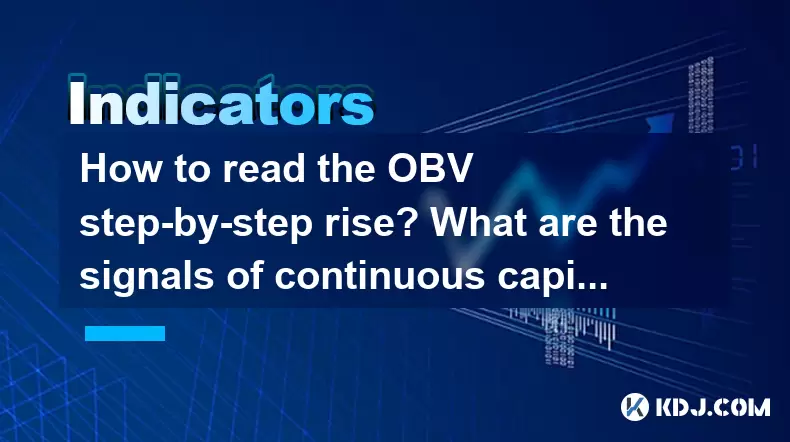-
 bitcoin
bitcoin $87959.907984 USD
1.34% -
 ethereum
ethereum $2920.497338 USD
3.04% -
 tether
tether $0.999775 USD
0.00% -
 xrp
xrp $2.237324 USD
8.12% -
 bnb
bnb $860.243768 USD
0.90% -
 solana
solana $138.089498 USD
5.43% -
 usd-coin
usd-coin $0.999807 USD
0.01% -
 tron
tron $0.272801 USD
-1.53% -
 dogecoin
dogecoin $0.150904 USD
2.96% -
 cardano
cardano $0.421635 USD
1.97% -
 hyperliquid
hyperliquid $32.152445 USD
2.23% -
 bitcoin-cash
bitcoin-cash $533.301069 USD
-1.94% -
 chainlink
chainlink $12.953417 USD
2.68% -
 unus-sed-leo
unus-sed-leo $9.535951 USD
0.73% -
 zcash
zcash $521.483386 USD
-2.87%
How to read the OBV step-by-step rise? What are the signals of continuous capital inflow?
A consistent OBV rise over time signals continuous capital inflow, indicating strong buying pressure and potential for price increases in cryptocurrencies.
Jun 06, 2025 at 01:28 am

The On-Balance Volume (OBV) indicator is a popular tool used by traders and investors to gauge the strength of market trends based on volume flow. Understanding how to read the OBV and identifying signals of continuous capital inflow can provide valuable insights into market movements. This article will guide you through the process of reading the OBV step-by-step and highlight the key signals of continuous capital inflow within the cryptocurrency market.
Understanding the OBV Indicator
The On-Balance Volume (OBV) indicator is a momentum indicator that uses volume flow to predict changes in stock price. Developed by Joe Granville, OBV helps investors understand whether a cryptocurrency is under accumulation or distribution. The core principle behind OBV is that volume precedes price movement. When the OBV line rises, it suggests that buying pressure is increasing, and when it falls, selling pressure is increasing.
To calculate the OBV, you start with an initial value (usually zero) and adjust it based on the volume of the trading day:
- If the closing price is higher than the previous closing price, add the volume to the OBV.
- If the closing price is lower than the previous closing price, subtract the volume from the OBV.
- If the closing price is the same as the previous closing price, the OBV remains unchanged.
Step-by-Step Guide to Reading OBV Rise
Reading the OBV can be broken down into a series of steps that help you interpret the data more effectively. Here is a detailed guide on how to read the OBV step-by-step:
Identify the OBV Line: The first step is to locate the OBV line on your charting platform. This line represents the cumulative volume based on the rules mentioned above.
Analyze the Trend: Look at the overall trend of the OBV line. An upward trend in the OBV suggests that the cryptocurrency is experiencing continuous buying pressure, which is a bullish signal. Conversely, a downward trend indicates increasing selling pressure, which is bearish.
Compare OBV with Price: Compare the OBV line with the price chart of the cryptocurrency. If the OBV is rising while the price is also rising, this confirms the bullish trend. However, if the price is rising but the OBV is falling, it could be a sign of a potential bearish reversal.
Look for Divergences: Divergences between the OBV and the price can be significant. A bullish divergence occurs when the price is making new lows, but the OBV is making higher lows. This suggests that buying pressure is increasing despite the falling price, which could indicate an upcoming bullish reversal. On the other hand, a bearish divergence occurs when the price is making new highs, but the OBV is making lower highs, suggesting that selling pressure is increasing despite the rising price.
Check for Breakouts: Pay attention to breakouts in the OBV. If the OBV breaks above a resistance level, it can signal a strong bullish move. Similarly, if the OBV breaks below a support level, it can signal a strong bearish move.
Signals of Continuous Capital Inflow
Identifying signals of continuous capital inflow is crucial for investors looking to capitalize on strong market trends. Here are the key signals to look for:
Consistent OBV Rise: A consistent rise in the OBV over a prolonged period is a strong signal of continuous capital inflow. This indicates that more investors are buying the cryptocurrency, leading to increased volume and price.
Volume Spikes: Look for significant volume spikes that coincide with upward price movements. Volume spikes during price increases are a clear indication of strong buying interest and capital inflow.
High Volume on Up Days: If the volume on days when the price is rising is consistently higher than on days when the price is falling, it suggests that there is more buying pressure than selling pressure. This is another sign of continuous capital inflow.
OBV Confirming Price Trends: When the OBV confirms the price trend, it reinforces the signal of continuous capital inflow. For example, if the price is in an uptrend and the OBV is also rising, it indicates that the buying pressure is sustained and capital is continuously flowing into the cryptocurrency.
Using OBV in Cryptocurrency Trading
Applying the OBV indicator in cryptocurrency trading can help traders make more informed decisions. Here are some practical tips for using OBV effectively:
Combine with Other Indicators: Using the OBV in conjunction with other technical indicators, such as moving averages or the Relative Strength Index (RSI), can provide a more comprehensive view of market conditions. For instance, if the OBV is rising and the RSI is in overbought territory, it might suggest that the bullish trend is strong but nearing a potential reversal.
Set Up Alerts: Many trading platforms allow you to set up alerts for specific conditions. Setting an alert for when the OBV breaks above a certain level can help you stay informed about potential bullish moves.
Backtest Strategies: Backtesting your trading strategies that incorporate the OBV can help you understand how effective they are. Use historical data to see how the OBV performed in different market conditions and adjust your strategies accordingly.
Practical Example of OBV Analysis
To illustrate how to apply the OBV analysis, let's consider a hypothetical scenario with a cryptocurrency called CryptoX:
Initial Setup: You open your charting platform and add the OBV indicator to the chart of CryptoX.
Observation: You notice that over the past month, the OBV line has been consistently rising, even when the price of CryptoX experienced minor pullbacks.
Analysis: You compare the OBV trend with the price trend and observe that both are moving upwards. Additionally, you spot a bullish divergence where the price of CryptoX made a lower low, but the OBV made a higher low.
Decision: Based on the consistent rise in the OBV and the bullish divergence, you decide that CryptoX is experiencing continuous capital inflow and consider it a good candidate for a long position.
Frequently Asked Questions
Q: Can the OBV be used for short-term trading as well as long-term investing?A: Yes, the OBV can be effectively used for both short-term trading and long-term investing. For short-term trading, traders often focus on shorter time frames and look for quick signals like volume spikes and OBV breakouts. For long-term investing, investors may use the OBV to confirm broader trends and ensure that the cryptocurrency is under continuous accumulation.
Q: How reliable is the OBV indicator in predicting price movements?A: The OBV indicator is generally reliable when used in conjunction with other technical analysis tools. While it can provide valuable insights into volume trends and potential price movements, it is not foolproof. Traders should always use multiple indicators and consider other market factors to increase the reliability of their predictions.
Q: What should I do if the OBV and price movements are diverging?A: If you notice a divergence between the OBV and price movements, it's important to take a closer look at other indicators and market conditions. A bullish divergence (price making lower lows, OBV making higher lows) could signal an upcoming bullish reversal, while a bearish divergence (price making higher highs, OBV making lower highs) might indicate a bearish reversal. Always consider additional factors like market news and other technical indicators before making a trading decision.
Q: Are there any specific cryptocurrencies where the OBV works better?A: The OBV indicator can be applied to any cryptocurrency. However, it tends to work better with cryptocurrencies that have higher trading volumes and more liquidity, such as Bitcoin and Ethereum. These cryptocurrencies have more reliable volume data, which enhances the effectiveness of the OBV indicator.
Disclaimer:info@kdj.com
The information provided is not trading advice. kdj.com does not assume any responsibility for any investments made based on the information provided in this article. Cryptocurrencies are highly volatile and it is highly recommended that you invest with caution after thorough research!
If you believe that the content used on this website infringes your copyright, please contact us immediately (info@kdj.com) and we will delete it promptly.
- PNC Makes History: First Major U.S. Bank to Offer Direct Bitcoin Trading with Coinbase Partnership
- 2025-12-10 01:15:02
- Bitcoin's US Trading Blues: Unmasking the Morning Dumps
- 2025-12-10 01:00:02
- Coinbase, CFTC, and Crypto Move: A New Era for Digital Assets in US Derivatives
- 2025-12-10 01:25:01
- Ripple's RLUSD Stablecoin Surges Past $1.3 Billion Market Cap, Fueled by Multi-Chain Strategy and Institutional Partnerships
- 2025-12-10 01:10:02
- Horizen's Big Apple Pivot: Privacy's New Layer 3 Frontier on Base
- 2025-12-10 01:05:01
- Hacken Confirms MEXC's Ironclad Asset Backing, Bolstering Crypto Trust and Transparency
- 2025-12-10 01:10:02
Related knowledge

How to Combine Japanese Candlesticks with Western Chart Patterns (like Head and Shoulders)?
Dec 04,2025 at 02:40pm
Understanding Japanese Candlesticks in Modern Trading1. Japanese candlesticks offer a visual representation of price movement within a specific timefr...

Can a Gravestone Doji at a Key Resistance Level Signal a Perfect Short Entry?
Nov 28,2025 at 09:40pm
Understanding the Gravestone Doji in Technical Analysis1. The Gravestone Doji is a candlestick pattern characterized by an opening and closing price t...

How to Tell if a Crypto Breakout is Real Using Candlestick and Volume Analysis?
Nov 28,2025 at 05:39am
Understanding the Anatomy of a Genuine Crypto Breakout1. A true breakout in the cryptocurrency market is not defined solely by price surpassing a resi...

The Definitive Guide to Entry and Exit Points Using Crypto Candlestick Patterns.
Nov 29,2025 at 06:59am
Understanding Bullish Reversal Patterns1. The hammer candlestick pattern typically appears at the end of a downtrend and signals a potential reversal....

What Does a Closing Marubozu Mean for the Next Day's Crypto Price Action?
Nov 28,2025 at 02:19am
Understanding the Marubozu Candlestick Pattern in Crypto Trading1. A Marubozu candlestick is a single-bar pattern characterized by the absence of uppe...

How to Filter Out Noise Using Longer Timeframe Candlestick Charts in Crypto?
Nov 28,2025 at 11:40pm
Understanding the Value of Higher Timeframes in Crypto Analysis1. Higher timeframe charts such as daily and weekly candlesticks offer a broader perspe...

How to Combine Japanese Candlesticks with Western Chart Patterns (like Head and Shoulders)?
Dec 04,2025 at 02:40pm
Understanding Japanese Candlesticks in Modern Trading1. Japanese candlesticks offer a visual representation of price movement within a specific timefr...

Can a Gravestone Doji at a Key Resistance Level Signal a Perfect Short Entry?
Nov 28,2025 at 09:40pm
Understanding the Gravestone Doji in Technical Analysis1. The Gravestone Doji is a candlestick pattern characterized by an opening and closing price t...

How to Tell if a Crypto Breakout is Real Using Candlestick and Volume Analysis?
Nov 28,2025 at 05:39am
Understanding the Anatomy of a Genuine Crypto Breakout1. A true breakout in the cryptocurrency market is not defined solely by price surpassing a resi...

The Definitive Guide to Entry and Exit Points Using Crypto Candlestick Patterns.
Nov 29,2025 at 06:59am
Understanding Bullish Reversal Patterns1. The hammer candlestick pattern typically appears at the end of a downtrend and signals a potential reversal....

What Does a Closing Marubozu Mean for the Next Day's Crypto Price Action?
Nov 28,2025 at 02:19am
Understanding the Marubozu Candlestick Pattern in Crypto Trading1. A Marubozu candlestick is a single-bar pattern characterized by the absence of uppe...

How to Filter Out Noise Using Longer Timeframe Candlestick Charts in Crypto?
Nov 28,2025 at 11:40pm
Understanding the Value of Higher Timeframes in Crypto Analysis1. Higher timeframe charts such as daily and weekly candlesticks offer a broader perspe...
See all articles










































































